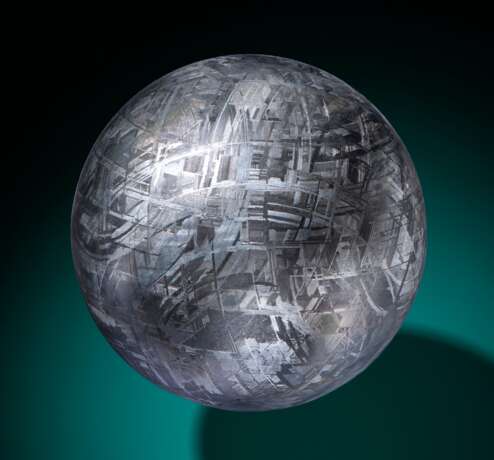MUONIONALUSTA METEORITE CRYSTAL BALL — CRYSTALLINE STRUCTURE OF AN IRON METEORITE DRAMATIZED IN THREE DIMENSIONS
23.02.2021 10:00UTC -05:00
Classic
Verkauft
350000USD $ 350 000
| Auctioneer | CHRISTIE'S |
|---|---|
| Veranstaltungsort | Vereinigten Staaten, New York |
Archiv
Die Auktion ist abgeschlossen. Es können keine Gebote mehr abgegeben werden.

ID 491228
Los 18 | MUONIONALUSTA METEORITE CRYSTAL BALL — CRYSTALLINE STRUCTURE OF AN IRON METEORITE DRAMATIZED IN THREE DIMENSIONS
Schätzwert
$ 14 000 – 18 000
Muonionalusta meteorites formed deep in the iron core of an asteroid that resided between Mars and Jupiter. An enormous impact event later shattered this asteroid and what was to become the Muonionalusta mass was ejected into interplanetary space. Possessing what is among the highest terrestrial ages of any meteorite, Muonionalusta fell to Earth about one million years ago. Despite its age, many specimens exhibit only minor interior weathering due both to the stability of the material as well as to being kept in the freezer of the Arctic. Muonionalusta specimens are believed to be glacial erratics (material transported by a glacier), and their exposure to churning rocks and ice for tens of thousands of years could account for the smooth surface and prosaic shapes of most specimens. As a result of being in one of Earth's largest rock tumblers, Muonionalusta meteorites were most often rendered unsuitable for exhibit as sculptural forms, and instead have been dissected to reveal their internal splendor in slices, spheres, watch faces and other jewelry.
As the crystalline intergrowth seen does not appear in terrestrial iron ores, its presence is diagnostic for iron meteorites, and pattern variations are frequently indicative of different meteorites. This latticework, referred to as a Widmanstätten pattern,is a product of the solid-state intergrowth of two different iron-nickel minerals: kamacite (the low-nickel variety) and taenite (the high-nickel variety).
When fashioned into a sphere, Muonionalusta meteorites are able to reveal in three dimensions its prominent crystalline fingerprint in a captivating perspective not available when viewing a flat surface in this mesmerizing and select crystal ball from outer space. Modern fashioning.
Christie's would like to thank Dr. Alan E. Rubin at the Department of Earth, Planetary, and Space Sciences, University of California, Los Angeles for his assistance in preparing this catalogue.
103mm (4 in.) diameter and 4.677 kg (10.3 lbs)
| Adresse der Versteigerung |
CHRISTIE'S 20 Rockefeller Plaza 10020 New York Vereinigten Staaten | ||||||||||||||
|---|---|---|---|---|---|---|---|---|---|---|---|---|---|---|---|
| Vorschau |
| ||||||||||||||
| Telefon | +1 212 636 2000 | ||||||||||||||
| Fax | +1 212 636 4930 | ||||||||||||||
| Nutzungsbedingungen | Nutzungsbedingungen | ||||||||||||||
| Versand |
Postdienst Kurierdienst Selbstabholung | ||||||||||||||
| Zahlungsarten |
Banküberweisung | ||||||||||||||
| Geschäftszeiten | Geschäftszeiten
|


